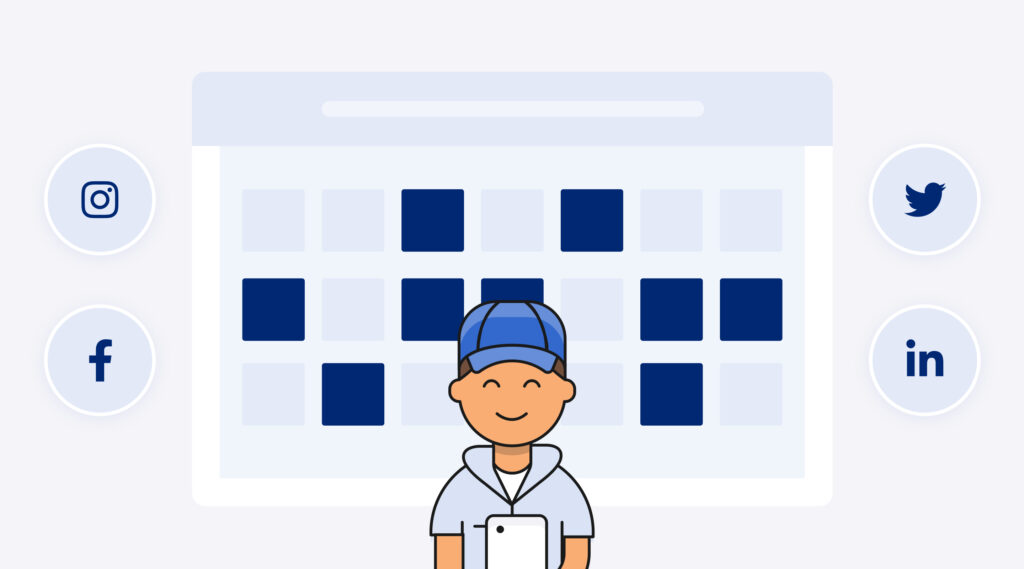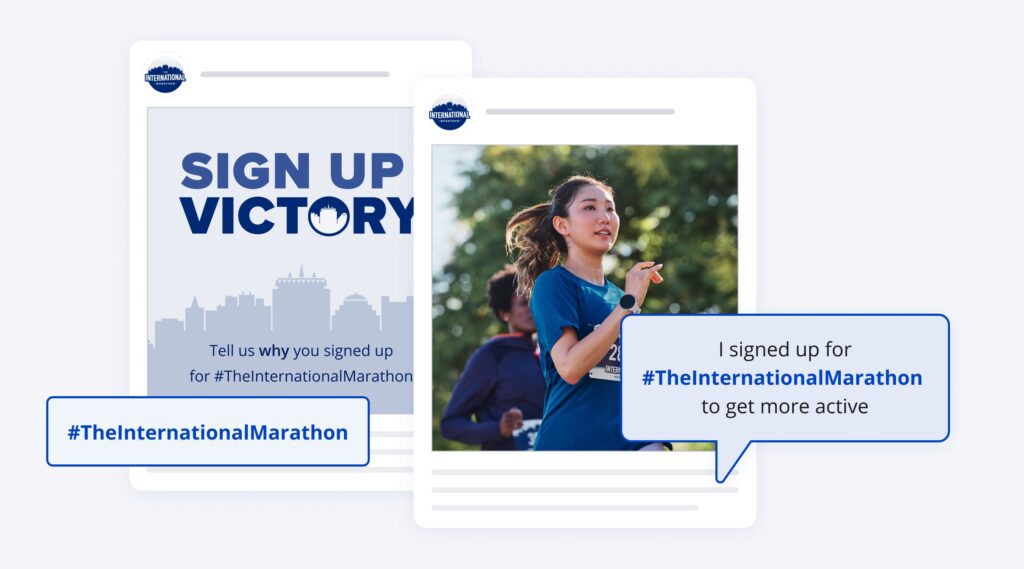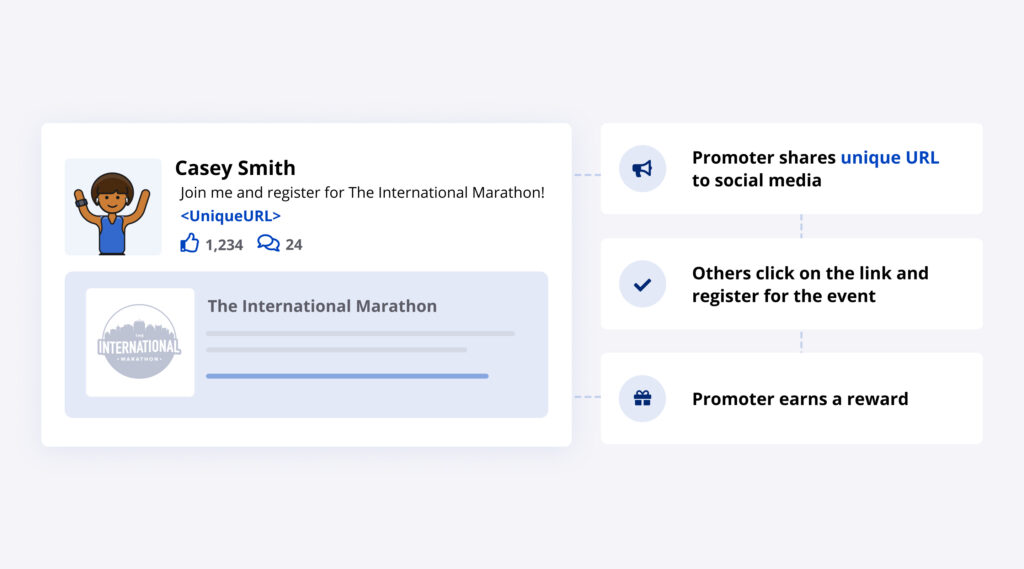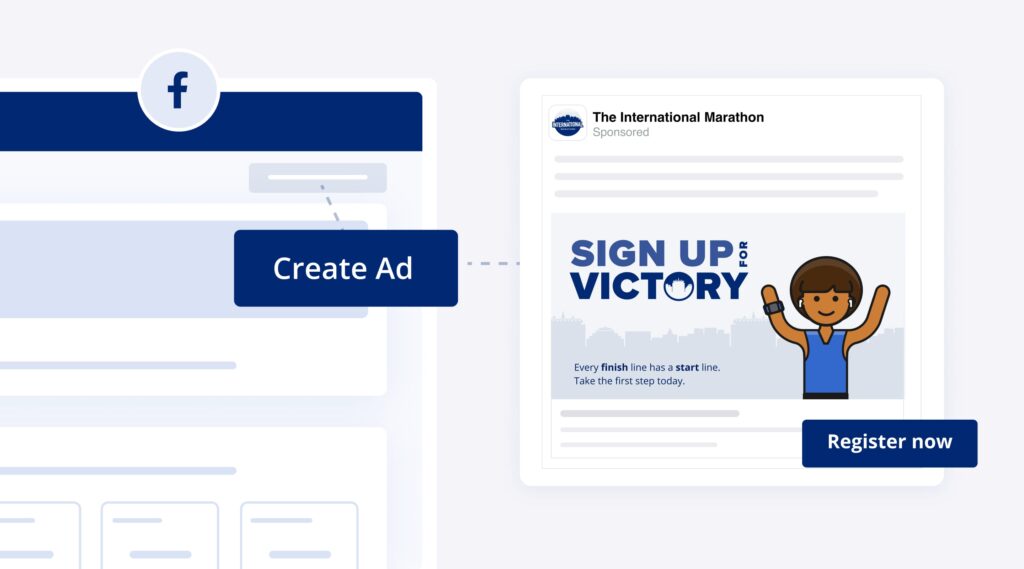Tips & Tricks | Estimated Read time – 7:05
A social media plan should be an essential part of every event organizer’s digital marketing strategy.
With a considered approach to event social media marketing, you can connect with more potential attendees and drive registration rates up.
We’ve compiled a few social media marketing strategies you can use to help generate awareness, create excitement, and boost registration at your next event.
1. Pick your social media platforms and start planning

When someone hears about an event like yours, social media is the first place they go to find more information. You need to make it as easy as possible for these potential registrants to find your event and sign up quickly.
Start planning your social media marketing strategy by determining what social media platforms will be the most effective for your event.
If you’re using Instagram or Facebook, consider setting up your social media profiles as business pages so you can get in-depth analytics and access to paid ads (more on that below). Remember to include links to your website in your account bios so it’s simple for new users to register for your event.
Next, research the best times to post and create a calendar. This will help keep your social media strategy organized as your event date gets closer and you get busier.
Here are tips to help you start posting effectively on social media:

1. Consider time of posting – Plan to post at times that most people tend to use social media: in the morning before their day gets started and when they’re winding down in the evening.

2. Schedule posts in advance – Effective social media marketing doesn’t have to take up a large chunk of your day. You can schedule posts a week, or even a month, in advance—whatever works best for your schedule.

3. Review & revise – Once you’ve posted enough and create a following, you can see when your social media posts are getting the best interaction and tweak your posting schedule for your audience.
Finally, start posting relevant, up-to-date content on your social media channels and begin to interact with your audience. It might seem daunting at first, but you’ll see growth for your event if you’re posting and interacting on a regular basis.
For new or smaller endurance events, try to interact as much as possible to grow your following. Regularly check your mentions and reply to everyone, answer any questions users are asking, and create interactions by mentioning people who are continually interacting with your posts. Building that 1-on-1 connection with your followers will go a long way in generating momentum for your event.
If your event is well-established or larger, strategically use your followers’ comments, questions, and reactions as promotion. The interactions you have with your followers are pieces of communication that can be helpful for anyone who sees them and builds connection with everyone in your community.
2. Create and promote an event hashtag
A hashtag is a word or collection of words prefaced by the ‘#’ symbol used to group content on social media platforms.
When used effectively, a good hashtag is an excellent tool for generating event awareness. It encourages participants to post on their social media in the lead-up to your event. This helps grow excitement, a sense of community, and your number of registrants.
The benefits of a good hashtag don’t stop there.
You can use your event’s hashtag to track engagement and measure interest in your event. You can use it to see what people are saying about your event and make valuable improvements on the fly. You can even use it to find great user-generated content that you can post across your event’s social media channels (keep reading for more on that).
What are the best practices for creating an effective event hashtag?

Pick a hashtag that’s easy to remember. Consider your event name, a catchy tagline, or a short acronym (but be aware! Audience can mix up letters).

Make sure the phrase you choose as your hashtag is easy to read without spaces. Consider capitalizing each new word.

Be concise. The ideal length for an effective hashtag is less than 24 characters.

Search your hashtag to ensure it hasn’t been used widely or is too close to a popular hashtag that already exists.

Promote your hashtag. Any opportunity to add text, ask yourself if it makes sense to add your hashtag. Even places like email signatures is an opportunity to add your hashtag!

Use your hashtag in social media posts before, during and after your event.

Incentivize participants to use your hashtag. For example, select a post using your hashtag at random every week in the lead-up to your event for a swag giveaway. Or ask participants to leave a post-event review using your hashtag for a chance at a discount for entry next year.
3. Post user-generated content

We get it. You’re in the middle of organizing an event. The idea of having to create content for social media on a regular basis can be daunting, especially with so many other things on your plate.
This is where user-generated content (UGC) can be a big help.
Use your social media channels to encourage event registrants to share content of their own (including your new event hashtag of course). Here are a couple of ideas to get you started:

Idea 1: “We’d love to see your training in action! Take a selfie or video or your next run, share it using #TheInternationalMarathon, and we’ll repost our favorites.”

Idea 2: “Why do you run? We want to hear your story. Share the reasons behind your motivation and tell us why you signed up for #TheInternationalMarathon.”
You can also engage with charitable and corporate partners for impactful UGC. Repost any of the content your partners share that has relevance to your event and ask them about opportunities for cross-promotion on their social media channels.
User-generated content isn’t just easy content. It’s honest and authentic content that can turn potential registrants into event participants. When people see that their family, friends, and peers are excited for your event, they’re more likely to sign up for it than if they were only hearing about it from you.
4. Incentivize social media referrals

There’s no better promoter for your event than the people who have already signed up. Like the value of UGC, using your event’s current registrants to find more potential registrants can lead to real results.
That’s why Race Roster created the social referral tool. This tool allows you to turn your participants into promoters by providing them with a unique URL to share with friends and family and on their social media channels.
When someone registers for your event using this unique URL, the promoter will receive a reward—the item and value of which is completely up to you. If you choose to offer a cash reward, we recommend a reward of 10% of the event registration fee.
Event organizers who use our social referral tool have experienced an impressive increase in registration as a result. The tool has helped organizers grow their endurance events by upwards of 12–15%.
Using the Race Roster social referral tool is easy. Here’s how it works.
5. Utilize paid ads on social media platforms

Growing your event registration using organic social media posts can lead to measurable success. But sometimes spending money to boost your top-performing posts can go a long way in increasing awareness and registration.
Boosting your social media posts allows you to go beyond the people who are already following or engaging with you. You can reach new audiences who you may not be able to get through to otherwise.
With page promotion on Facebook, you can choose to boost well-performing existing posts or create new, customized paid ads for specific target audiences.
What’s the best way to utilize paid ads on social media? Here are five helpful tips:

Target your social media ads to the audiences you want to reach. At minimum, target the specific area where you expect most of your participants to come from and users who have an interest in running. Even those two simple targeting options will go a long way in growing your registration.

Write attention-grabbing copy and use eye-catching visuals on your social ads.

Use every feature, including boosted posts, sponsored stories and video ads, to maximize your reach.

Experiment with different formats and strategies to see what works best for your event and budget.

Monitor results closely and adjust your approach, if needed. This will help you increase event registration numbers.
The sky’s the limit with an effective event social media marketing strategy. By optimizing your social media channels, posting and interacting on a regular basis, and taking advantage of the many tools at your disposal, you can increase event registration and help make your event one to remember.

What’s new at Race Roster?
Visit our what’s new page for the most noteworthy Race Roster updates!